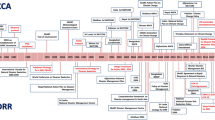
Overview
- Provides an overview of the current scale and estimate of investment in disaster risk reduction
- Proposes policies and practical approaches useful for policy makers and practitioners
- Includes case studies to analyze budget data collected in selected Asian countries
Part of the book series: Disaster Risk Reduction (DRR)
Access this book
Tax calculation will be finalised at checkout
Other ways to access
About this book
To date, various international arenas have recommended increasing investment in DRR. The Sendai Framework for DRR, adopted by the UN member states in 2015 during the Third UN World Conference on DRR, emphasizes investment as a priority for decreasing disaster risks and losses. The Yangon Declaration set the goal of doubling investment to address water-related disasters. However, most countries are not able to proactively invest enough in DRR. Understanding the current scale and estimate of investment and its effects is crucial for promoting DRR investment, but such information and estimates are rarely available.
This book examines the current investment trends and issues in DRR and CCA. Based on specific case studies, field data and evidence, the book identifies challenges in increasing investment and recommends various investment policies and innovative approaches to sustainable progress towards a resilient future.
Chapter 12 is available open access under a Creative Commons Attribution 4.0 International License via link.springer.com.
Similar content being viewed by others
Keywords
Table of contents (12 chapters)
-
Front Matter
-
Understanding the Context: Investing in Disaster Risk Reduction and Climate Change Adaptation in Asia
-
Front Matter
-
-
Case Studies
-
Front Matter
-
-
Policy for Bridging Gaps
-
Front Matter
-
Editors and Affiliations
About the editors
Dr. Mikio Ishiwatari is a senior advisor on disaster management and water resources management at the Japan International Cooperation Agency, and a visiting professor at the Graduate School of Frontier Sciences, The University of Tokyo. He has been engaged in projects and research work on disaster risk reduction, climate change adaptation, and water issues. He led the formulation of the Japanese assistance policies of climate change adaptation and community-based disaster management.
At the World Bank he worked as a senior disaster risk management specialist and published Learning from Megadisaster: Lessons from the Great East Japan Earthquake. He worked in various positions at the Ministry of Land, Infrastructure, and Transport, Japan, for 17 years, and was responsible for research and technology development as a senior deputy director for river technology and information. He also worked as an urban development specialist at the Asian Development Bank. He holdsa Ph.D. in international studies and an M.Sc. in urban engineering from The University of Tokyo.
Dr. Daisuke Sasaki is an associate professor of the International Research Institute of Disaster Science (IRIDeS) at Tohoku University in Sendai, Japan. He holds a Ph.D. (2015) in international studies and also has expertise in disaster science.He has been continuously conducting research focusing on the factors that might hinder the resolution of regional issues from the perspective of international cooperation both qualitatively and quantitatively, and also engaged in plenty of international collaborative research with several universities in the Asia-Pacific region.
Dr. Sasaki has published a number of articles in refereed journals including the International Journal of Disaster Risk Reduction (IJDRR), and he has served as a guest editor for several special issues of the Journal of Disaster Research (JDR).
Bibliographic Information
Book Title: Financing Investment in Disaster Risk Reduction and Climate Change Adaptation
Book Subtitle: Asian Perspectives
Editors: Mikio Ishiwatari, Daisuke Sasaki
Series Title: Disaster Risk Reduction
DOI: https://doi.org/10.1007/978-981-19-2924-3
Publisher: Springer Singapore
eBook Packages: Earth and Environmental Science, Earth and Environmental Science (R0)
Copyright Information: The Editor(s) (if applicable) and The Author(s), under exclusive license to Springer Nature Singapore Pte Ltd. 2022
Hardcover ISBN: 978-981-19-2923-6Published: 02 September 2022
Softcover ISBN: 978-981-19-2926-7Published: 03 September 2023
eBook ISBN: 978-981-19-2924-3Published: 01 September 2022
Series ISSN: 2196-4106
Series E-ISSN: 2196-4114
Edition Number: 1
Number of Pages: XII, 200
Number of Illustrations: 10 b/w illustrations, 30 illustrations in colour
Topics: Natural Hazards, Investment Appraisal, Climate, general



